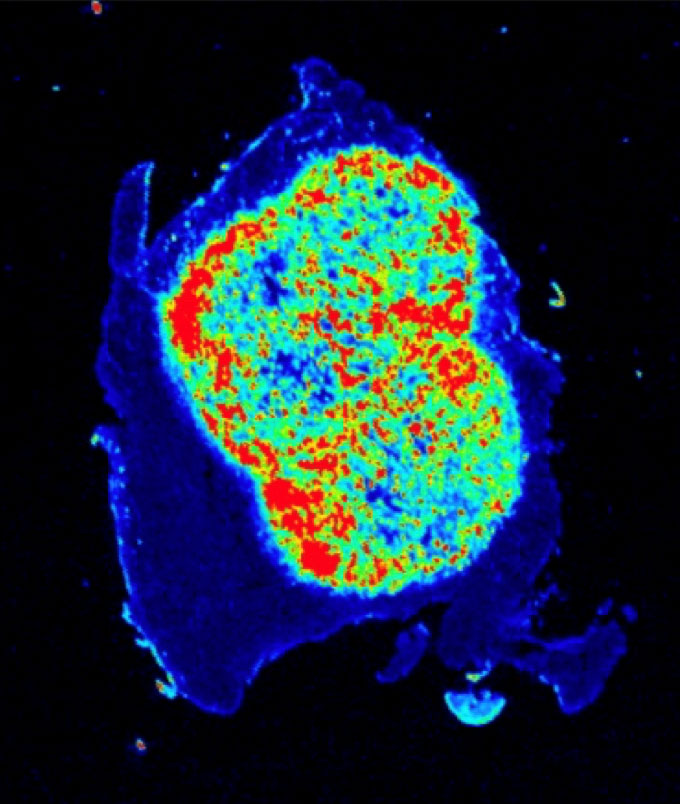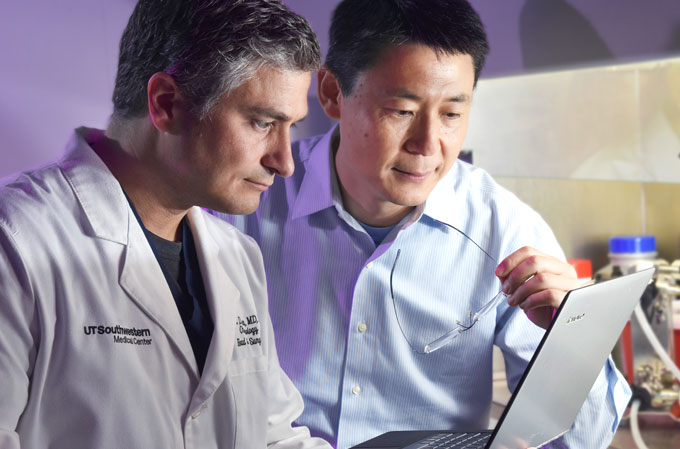A nano partnership with macro potential
Illuminating cancer like a beacon, a digital pH sensor invented at UT Southwestern seeks to improve the accuracy of tumor surgeries. This potentially game-changing technology came to fruition through the unique, long-term collaboration of two UT Southwestern faculty members – a cancer surgeon and a scientist with expertise in biomedical engineering and pharmacology.
The nanosensor, which works by reacting to low pH, is designed to accurately distinguish cancerous from healthy tissue and make it easier for surgeons to remove cancer cells while leaving healthy, functional tissue intact.
“We synthesized an imaging probe that stays dark in normal tissues but switches on like a lightbulb when it reaches solid tumors. The purpose is to allow surgeons to see tumors better during surgery,” says Dr. Jinming Gao, Professor of Pharmacology and Otolaryngology with the Harold C. Simmons Comprehensive Cancer Center.
“This new digital nanosensor-guided surgery has several potential advantages for patients, including more accurate removal of tumors and greater preservation of normal tissue by limiting the extent of surgery, which we hope would improve quality of life and patient survival”
The nanosensor amplifies pH signals in tumor cells to more accurately distinguish them from normal cells.
“Cancer is a very diverse set of diseases, but it does have some universal features,” says surgeon Dr. Baran Sumer, Associate Professor of Otolaryngology with the Simmons Cancer Center. “Tumors do not have the same pH as normal tissue. Tumors are acidic, and they secrete acids into the surrounding tissue. It’s a very consistent difference and was discovered in the 1920s.”
“When Baran was first recruited to UT Southwestern, he was interested in nanotechnology and I was put on his interview calendar,” recalls Dr. Gao, who holds the Robert B. and Virginia Payne Professorship in Oncology. “I thought he was just curious about research but may not have time for it. To my surprise, he was really committed. He came and talked to the students and attended lab meetings. It was very helpful for the lab to see through the eyes of a physician and for them to appreciate the unmet clinical need.”
Dr. Gao and Dr. Sumer – who have been working together for more than a decade – developed the sensor and integrated it with a clinical camera to allow surgeons to see the fluorescent areas. The nanosensor lights up cancer while also suppressing the signal in normal tissue, leading to a sharp contrast between cancerous and healthy tissue. It is expected to be effective in most solid tumors.

“This new digital nanosensor-guided surgery has several potential advantages for patients, including more accurate removal of tumors and greater preservation of normal tissue by limiting the extent of surgery, which we hope would improve quality of life and patient survival,” says Dr. Sumer, who leads the Head and Neck Oncology team at the Simmons Cancer Center.
The invention includes the use of an intravenously injected nanosensor medication that causes tumors to light up and remain fluorescent for up to two days.
“What we have is a digital probe that might eventually lead to more exact surgeries so that solid-cancer surgeries would not need to be followed up with radiation or chemotherapy,” Dr. Sumer says, adding that it will take clinical trials to determine its usefulness.
“I’m excited about the amount of information that this probe has the potential to give me while I’m doing surgery,” he adds.
The nanosensor technology and the camera used to see the fluorescent cells are being developed by OncoNano Medicine Inc., which was the recipient of a Cancer Prevention and Research Institute of Texas product development award. Dr. Gao and Dr. Sumer are paid consultants and scientific co-founders of the company. UT Southwestern has licensed the technology to OncoNano Medicine and has a financial interest in the research.
After more than a decade of collaboration, the research duo is still going strong.
The two worked on MRI contrast agents and photodynamic therapy for cancer in the early days. They rejected a few projects along the way before the seed was planted for the digital nanosensor.
“We had a conversation one day where Baran told me about the importance of tumor visualization during surgeries,” Dr. Gao says. “We thought about designing a fluorescent agent that could be turned on by tumor signals, and this initial idea has proved to be a game changer. It took many years to synthesize different polymers and test them in animal models. Now we have a potential clinical product.”
The biggest challenge in their partnership – as in any relationship – is when the researchers have wanted to pursue different priorities.

“We’ve had times where we were very much in sync and times where we were not,” Dr. Sumer says. “Sometimes we were disagreeing about the direction to take the research. But if you can work through that disagreement, it makes the collaboration even stronger and allows you to do even more exciting research projects. That takes a lot of communication and a lot of time and commitment on the part of both researchers.”
Dr. Sumer points to several secrets to their collaboration’s longevity. “Our personalities are very complementary. Jinming is very focused and selective, and I like keeping a broad, diverse perspective. Also, we met at just the right time. He was established but was looking for critical clinical problems. I was established clinically, but just getting started in research. The most important factor is that we just enjoy bouncing ideas off of each other.”
“We’re still learning from each other,” Dr. Gao says. “We spend a lot of time together and we talk a lot about how to synergize our efforts.” It has been a marathon of teamwork to turn a laboratory discovery into a clinical product with the potential to help patients, he added. Besides tumor imaging, the team is also investigating the use of the technology for treatment of cancer and metabolic diseases.
The researchers agree that UT Southwestern has a uniquely collaborative environment.
“UT Southwestern provides an outstanding environment for translational research,” Dr. Gao says. “It allows people like us to go beyond what we do individually, beyond our own comfort zone, to reach out to the other side. The environment and expectation for excellence allow us not only to do our best science but also tackle projects with the potential to help people.”
“Patients always come first, but if you also make time to do research, then you can address long-term goals to improve health care,” Dr. Sumer adds. “Research forces us to think creatively about ways to improve human health. It takes a lot of investment in time and hours of face-to-face brainstorming sessions, but the ultimate rewards are tangible – not just for our patients, but patients everywhere.”

